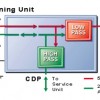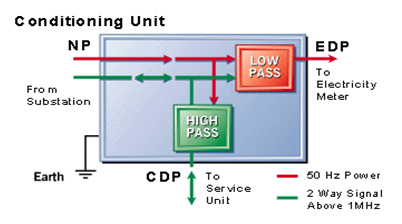Power Line Communications

Power Line Communication (PLC) is a rapidly developing technology that utilizes electricity power lines for the high-speed transmission of data and voice services. Using the power supply lines that exist in homes or offices, PLC can bring very high speed connectivity to home, schools, hotels and many more places. Internet connectivity is inevitable today and offering a high speed outreach has been a challenge. PLC can solve this problem by providing at least 1 Mbps speed – 20 times faster than a standard phone/modem connection. There are various other applications that PLC can provide which include whole-house audio, security & monitoring, smart homes, internet telephony, video communications, broadband over power line and many more.
History:
The idea of sending communication signals on the same pair of wires that are used for power distribution is as old as the telegraph itself. Early experiments with communication over a Power Network were first held in the 1920s by the energy providers, to establish cheap communication between their plants. The basic idea was to use an existing network for communication and not introduce or establish a new one. In the 1920s two patents were issued to the American Telephone and Telegraph Company in the field of “Carrier Transmission Over Power Circuits”. United States Patents numbers 1,607,668 and 1,672,940, filed in 1924 show systems for transmitting and receiving communication signals over three phnase AC power wiring.
Later on, this concept was adapted to the control of street lighting. So all street lights could be turned on and off by a central “switch” and the lights only needed a small decoder chip. By using this technique, no additional wires were needed to control the lights.
In today’s environment, PLC is being seen as an alternative for the so called “last mile”. Contrary to this, in earlier days PLC was primarily used for telegraph and telephone communication and only low speed transmission could be obtained over long distances. Later, first PLC system to appear was a metering system created by General Electric. It would operate on a 35 to 40 KHz frequency range. However, propagation and transformer couplings losses proved to be a significant obstacle. In 1980s, better metering system namely AMRAC III was developed. Frequency range was shifted down to 5-10 KHz so the losses are minimized and acceptable. In the late 80s, Rockwell system was developed. This system, in addition to metering, would also provide load management and distribution automation. In recent times, commercial spread spectrum power line communication has gained a lot of attention for R&D with a slew of companies. Today, PLC is primarily being sought to bring the high speed internet connectivity to every part of the world.
Interestingly, PLC Systems have long remained a favored choice for utilities because they leverage existing assets. Recent advancements in Smart Grid and rapidly expanding deployments of advanced metering infrastructure have given further impetus to PLC systems. As per a recent industry report, total shipments of PLC nodes are projected to reach nearly 68 million units by 2020, up from 41.2 million in 2011. The lion’s share of the market will come from the Asia Pacific region, which will account for almost three-quarters of the shipments in 2020, the finding concludes.
As some industry analysts see it, several European and Asia Pacific utilities are likely to deploy PLC-based systems since they can be more affordable and allow for more rapid deployments than adopting a wireless technology. Although data speeds over PLC systems are far slower than wireless, PLC does offer a high degree of reliability.
By sheer number of communications nodes, the bulk of utility-based PLC deployments today are focused on connecting meters. The types of PLC technology being deployed, however, vary widely. Such PLC systems range from older, legacy solutions that are used for basic meter reading and line monitoring to high-speed, broadband solutions that are being piloted in several markets.
Brief Overview of Technology:
PLC operates by high frequency data signals transmitted through the existing power cable network which is used for carrying electricity power to home users. This type of signal cannot pass through a transformer. It requires instruments which combines the voice and data signals with the low-voltage supply current in the local transformer stations. Digital power line technology uses High frequency conditioned power network (HFCPN) for transmitting data and electrical signals. It consists of series of Conditioning Units (CU) to filter those separate signals. The CU sends electricity to the outlets in the home and data signals to a communication module or service unit. The communication module provides multiple channels for data, voice, etc.
The HFCPN Conditioning Unit:
The Conditioning Unit (CU) for the Digital Power line Network is located near the electric meter at each customer’s home. The CU uses band pass filters to isolate electricity and data signals. This makes the link between a customer’s home and an electricity substation. The CU consists of 3 coupling ports. As shown in the figure, the device receives input from its network port (NP). This input passes into high pass and low pass filter. High pass filter sends data signals to communication distribution port while low pass filter sends electrical signals to electricity distribution port (EDP). The 50Hz signal passes from low pass filter and to the electrical meter. This low pass filter attenuates noise

generated by electrical appliances at customer’s home. This noise would cause significant amount of distortion if it’s not removed. The high pass filter provides two way data traffic to and from the customer’s location. Data signals flow through the CDP to the customer’s service unit via standard coaxial cable. The service unit is a wall or table mountable multi-purpose data communications box. This unit makes data connections via BNC connectors to cable modems and telephone connections via standard line termination jacks.
PLC Specifications and Standards:
PLC, which carries data over power wiring, often includes home electrical wiring, using technologies such as HomePlug standards.
HomePlug 1.0:
- Introduced in June 2001, first available in 2002
- Provides max PHY rate of 14Mbps
- Certified by the HomePlug Powerline Alliance
- Interoperable with 85Mbps rated devices. Standardized by the ANSI-accredited Telecommunication industry association in May 2008 as TIA-1113.
HomePlug AV:
- Introduced in August 2005, first available in 2006
- Provides max PHY rate of 200Mbps
- Certified by the HomePlug Powerline Alliance
- Interoperable with IEEE 1901 and HomePlug 1.0 devices. Some HomePlug AV devices incorporate semiconductors that use proprietary extensions to HomePlug AV technologies and achieve 500Mbps PHY rate.
IEEE 1901:
- Introduced in June 2005, first available in 2010
- Provides max PHY rate of 545Mbps
- Certified by the HomePlug Powerline Alliance
- IEEE 1901 technology includes PHYs interoperable with both HomePlug AV and HD-PLC and provides smart coexistence through an Inter-system Protocol
HomePlug AV2:
- Introduced in January 2012
- Provides a gigabit-class PHY rate
- Interoperable with HomePlug AV and HomePlug Green PHY devices
HomePlug GP (“Green PHY”):
- First available in early 2011
- Provides max PHY rate of 10Mbps because it targets smart grid applications
- HomePlug GP uses 75% less power, and is a cost-optimized, lower data rate version of HomePlug AV, IEEE 1901, and HomePlug AV2.
Advantages of PLC:
- No additional wiring
- Mobility
- Flexibility
- Easy to install and use
- Compatible with all other technologies like ADSL, Wi-Fi, Cable, Satellite
- Stability
- High speed data communication
Disadvantages of PLC:
- Installation and high performance depend on the architecture of the electrical network
- Lack of standards and guidelines
- Interoperability problems with various types of equipments
- Current price, market needs to be developed
Conclusion:
PLC is a promising emerging technology, which has attracted much attention because of the wide availability of electricity power lines. Also this technology is a great substitute for internet connection via phone and modem. In addition, its high speeds will provide internet access, video on demand, local phone, and long distance phone services to several customers. While it suffers from some limitations, many industry watchers believe that PLC would not fade away as it still has its uses, just not in home broadband. The technology is believed to have found a strong niche in Smart Grid space and is the leading technology used around the world for smart metering.
This article was also published on TechOnline. The link mentioned below will point you to it:




how we can implement HPAV2 in matlab